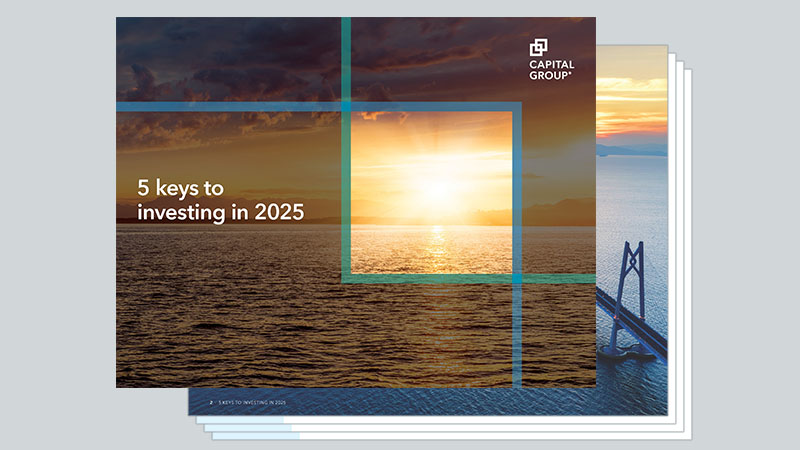Long-Term Investing
As we enter 2025, market optimism is high amid a strong United States economy, interest rate cuts and advances in artificial intelligence.
The S&P 500 Index ended 2024 up 25%, after topping 26% in 2023. Whether this year will be a three-peat of stellar market gains is unclear, but a handful of promising investment themes could support long-term gains. Here, our economist and portfolio managers highlight five key insights for investors in 2025 and beyond.
1. Welcome to the Benjamin Button economy
If you’re a fan of Brad Pitt movies or Capital Group’s 2025 Outlook, you’re probably familiar with the concept of aging in reverse. And while the Benjamin Button character is a work of fiction, the reversal of the U.S. business cycle has very real implications for investors.
The U.S. business cycle appears to be aging in reverse

Sources: Capital Group, MSCI. Positions within the business cycle are forward-looking estimates by Capital Group economists as of December 2023 (2024 bubble) and December 2024 (2025 bubble). The views of individual portfolio managers and analysts may differ. Returns data is monthly from December 1973 to August 2024 and includes all completed cycle stages through November 30, 2024. Data is Datastream U.S. Total Market Index from December 31, 1973 to December 31, 1994, and MSCI USA Index data thereafter. Past results are not predictive of results in future periods.
“Instead of moving through the typical four-stage cycle that has defined the post-World War II era, the U.S. economy appears to be shifting from late cycle back to mid cycle,” says Capital Group economist Jared Franz. The U.S. economy is benefiting from rising corporate profits, accelerating credit demand, softening cost pressures and a shift toward neutral monetary policy. “We saw all four of those in 2024,” Franz notes. “Going forward, I believe the U.S. is headed for a multi-year expansion period, perhaps fending off a recession until 2028.”
This also provides a favorable backdrop for stocks. Based on an analysis of returns during previous business cycles, we found that stocks posted a robust 14% return during the mid-cycle stage. This is notably higher than returns during a late-cycle environment. The move back to mid cycle also effectively postpones the start of the next recession — periods when stock returns have historically been their worst.
2. Industrial renaissance is fueling a new era of growth
From the American heartland to the arid desert, an industrial renaissance is underway. Capital expenditure (capex) projects are popping up across the U.S., boosting local economies and creating opportunities for select companies.
Taiwan Semiconductor Manufacturing Company’s $65 billion build-out of a production facility in Arizona is one notable example. It is expected to create thousands of manufacturing and construction jobs. But for every megaproject, there are dozens that remain under the radar. Eli Lilly, for example, is investing $4.5 billion to create a new drug development and manufacturing center that could bring hundreds of jobs to Indiana.
To be sure, this activity is happening outside America, too. The build-out of data centers, rising travel demand and the development of new energy sources are creating growth opportunities for Europe’s industrial titans. In emerging markets, the nearshoring movement is leading to a rewiring of supply chains and the construction of new trade hubs.
Investing in America: Grassroots manufacturing has surged

Sources: Capital Group, AreaDevelopment.com, Clean Investment Monitor, U.S. Census Bureau, Whitehouse.gov, company reports. Map markers reflect current and upcoming projects that have been announced as of November 30, 2024. Data reflect a sample of infrastructure and manufacturing investments across the U.S., and estimated investment amounts are expected to occur over various timelines. Capital expenditure (capex) is money invested for acquisitions, upgrades, renovations and adoption. It can be tangible (i.e., real estate) or intangible (i.e., licenses, software).
“These trends represent multi-decade investment opportunities, and we are only in the early innings,” says Lara Pellini, equity portfolio manager for The New Economy Fund®. “Industrial powerhouses in the U.S. and Europe are solidifying their foothold in areas ripe for long-term global growth.”
3. AI megatrend could boost stocks for years
Artificial intelligence has captured the minds of the public and investors, conjuring images of a futuristic world completely reshaped by intelligent machines. Overhyped? Probably. Even more opportunities ahead? Also probably true.
That’s because we tend to overestimate megatrends in the short term while underestimating them in the longer term. With some megatrends, such as smartphones or driverless cars, we could reasonably create estimates based on known quantities like global populations or number of cars.
“But how do we measure the value of better intelligence?” asks Mark Casey, equity portfolio manager for CGGR — Capital Group Growth ETF and The Growth Fund of America®. “One of the most interesting things about AI is that it’s hard to predict how big it will become. Because it can take on a multitude of human tasks, I consider the AI market to be unknowably massive.”
Investors tend to underestimate the long-term impact of new technology

Sources: Morgan Stanley AI Guidebook: Fourth Edition, January 23, 2024; Next Move Strategy Consulting, Statista. Initial forecast dates were February 1996 for PC and internet users; January 2010 for smartphone shipments; March 2017 for cloud revenue; and January 2023 for AI market size.
Outside of its tech applications, AI will also create opportunities in some unexpected places. The build-out of data centers requires vast physical resources, including copper, capital equipment and a lot of electricity. Soaring demand for these resources has been a boon for old economy industries including utilities, industrials and mining companies.
4. Drug discovery is creating a golden age of health care
Following last year’s U.S. election, uncertainty over the industry’s regulatory outlook sparked a slump in health care stocks, further pressuring a sector that had lagged throughout the year. But following the sell-off, many companies are trading at attractive valuations, creating opportunities for investors with a long-term approach.
“That includes forgotten pharma, or drugmakers that don’t offer weight loss treatments,” according to Cheryl Frank, portfolio manager for American Mutual Fund® and CGCV — Capital Group Conservative Equity ETF. “I am looking for opportunities to invest in dividend payers that have been left behind by the market.”
While weight loss drugs, such as GLP-1s, tend to capture the spotlight, advances are being made on many other fronts. The largest pharmaceutical companies have more than two hundred drugs in their pipelines.
Advances in medicine likely to continue with hundreds of drugs in development

Source: Statista. Pipeline data is as of November 30, 2024.
As these companies tackle some of the world’s most debilitating ailments, patients have experienced lower mortality rates and longer life expectancies. Over the next decade, we could see effective treatments for ALS, sickle cell and muscular dystrophy. Risks are always present when investing in biotech and pharma companies, but we could be at the start of a golden age of health care — for patients and investors.
5. There are always reasons not to invest

Get the 5 keys to investing in 2025 report
Imagine going back in time to New Year’s Day 2020 and learning in advance about the biggest events over the next five years. The COVID-19 pandemic. A steep bear market. Inflation above 9%. Wars in Ukraine and the Middle East. A trade war with China. Political uncertainty in the U.S. With that knowledge, would you want to invest in stocks? Probably not.
“In my 25 years in the mutual fund business, I have never known a good time to invest. There are always a dozen reasons why it makes sense to wait. We have a new president, strife in the Middle East, excessive government regulation, oppressive tax rates and a Congress that is more part of the problem than the solution,” said former Capital Group executive Graham Holloway.
Although that may sound like a reflection of the current environment, Holloway’s quote is from 1981.
Markets have remained resilient in the face of turmoil and uncertainty

Sources: MSCI, RIMES. As of December 31, 2024. Data is indexed to 100 on January 1, 1987. Shown on a logarithmic scale. Markers refer to the starting year of each event. Past results are not predictive of results in future periods.
The point is there are always reasons not to invest, and that’s no different today than it was in 2020 or 1981. But markets have been resilient over time. And investors have typically been rewarded for overlooking near-term uncertainty and keeping focus on their long-term investment goals.
So, going back to New Year’s 2020, what would have happened if you ignored all the troubling events on the horizon and stayed invested? Since then, the S&P 500 Index has risen more than 100%.
The market indexes are unmanaged and, therefore, have no expenses. Investors cannot invest directly in an index.
Datastream U.S. Total Market Index measures the results of the U.S. equity market, including large-, mid- and small-capitalization stocks.
MSCI USA Index is a free float-adjusted, market capitalization-weighted index designed to measure the performance of the large- and mid-cap segments of the U.S. market.
MSCI World Index is a free float-adjusted, market capitalization-weighted index designed to measure equity market results of developed markets. The index consists of more than 20 developed market country indexes, including the United States.
S&P 500 Index is a market capitalization-weighted index based on the results of approximately 500 widely held common stocks.
MSCI has not approved, reviewed or produced this report, makes no express or implied warranties or representations and is not liable whatsoever for any data in the report. You may not redistribute the MSCI data or use it as a basis for other indices or investment products.
The S&P 500 Index is a product of S&P Dow Jones Indices LLC and/or its affiliates and has been licensed for use by Capital Group. Copyright © 2025 S&P Dow Jones Indices LLC, a division of S&P Global, and/or its affiliates. All rights reserved. Redistribution or reproduction in whole or in part is prohibited without written permission of S&P Dow Jones Indices LLC.
Get the 5 keys to investing in 2025 report
Explore the 2025 Midyear Outlook
Don't miss our latest insights.
Our latest insights
-
-
Emerging Markets
-
Global Equities
-
Economic Indicators
-
Related Insights
-
Global Equities
-
Economic Indicators
-
Markets & Economy
Don’t miss out
Get the Capital Ideas newsletter in your inbox every other week
 Jared Franz
Jared Franz
 Lara Pellini
Lara Pellini
 Mark Casey
Mark Casey
 Cheryl Frank
Cheryl Frank
